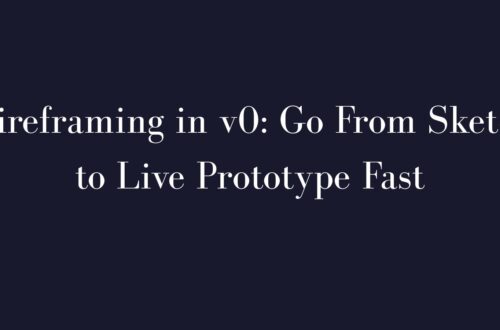The v0 Generative UI tool transforms plain-English prompts into reusable Tailwind CSS components. It’s fast, intuitive, and acts like an AI coding assistant. However, generated code often needs refinement. This guide shows best practices for writing effective prompts, cleaning Tailwind classes, extracting shared styles, and effectively reusing your components.
Prompt Tweaks
Crafting effective prompts is critical. Small wording adjustments drastically enhance the cleanliness of v0’s Tailwind output. For instance, a prompt like “a fancy blue button” generates messy Tailwind classes, whereas a refined prompt like “a blue primary button using Tailwind classes only, rounded corners, hover effect, no inline styles” yields cleaner, more maintainable results.
Best practices for prompt optimization:
- Be specific: Clearly describe elements, styles, and layouts.
- Good example: “A centered login form with 2 input fields and a submit button.”
- Mention Tailwind explicitly: Use phrases like “Tailwind utility classes” or “no custom CSS.”
- Iterate: Refine prompts if initial outputs are cluttered. Ask v0 explicitly to simplify or remove unnecessary styles.
Class Clean‑up
Even refined prompts need minor polishing. Review and clean the generated Tailwind classes to maximize readability and efficiency. Common fixes include:
- Remove duplicates: Eliminate redundant styles (e.g.,
bg-blue-500appearing twice). - Merge similar utilities: Replace individual classes (
mt-2 mb-2) with shorthand (my-2). - Use Tailwind shorthand: Condense padding/margins (
px-4 py-4→p-4). - Replace inline styles: Convert any inline or non-standard classes to standard Tailwind utilities.
- Run formatters and linters: Automatically organize and verify Tailwind classes.
Extracting Shared Styles
Repeated styles across multiple components should be centralized for consistency and maintainability. Use Tailwind’s @apply directive to consolidate commonly-used classes.
For example, multiple card components using:
className="bg-white rounded-xl shadow p-6"can share a reusable CSS class:
.cardBase {
@apply bg-white rounded-xl shadow p-6;
}Then simplify your JSX:
<div className="cardBase">...</div>Apply this practice broadly to buttons, alerts, panels, etc. This ensures DRY (Don’t Repeat Yourself) code and simplifies future style adjustments.
Pro Tip: Establish shared style classes early. Although v0 doesn’t know custom classes during generation yet, creating mappings post-generation streamlines future prompts. (v0’s team is currently enhancing support for custom design systems.)
Re‑using Components
Leverage v0 Generative UI’s power by treating generated snippets as permanent, reusable components rather than disposable examples.
Example: You generate header and footer components separately, each with navigation. Refactor the shared navigation into a single <NavBar> component used across both header and footer. Similarly, reuse a well-designed v0 button as a universal <Button> component.
Best practices for reusing components:
- Save Components: Transfer generated code into dedicated React component files. Assign clear, descriptive names.
- Import and Reuse: Integrate these components consistently across your app, rather than repeatedly generating new versions.
- Extend Components: For minor variations (like secondary buttons), use props or modifier classes instead of creating entirely new components.
This strategy transforms v0’s rapid prototyping into maintainable production code, boosting both speed and code quality.
FAQs
Can v0 generate pure Tailwind CSS components?
Yes, explicitly mention “Tailwind utility classes only” in your prompts for cleaner results.
Should I always manually edit v0-generated code?
Typically, yes. While v0 outputs valid Tailwind, small manual tweaks (like class simplification) enhance readability and maintainability.
How can I avoid repetitive styling across components?
Extract shared styles using Tailwind’s @apply directive into custom utility classes. This reduces duplication significantly.
Can v0 help build a component library for my project?
Absolutely. Use v0-generated components as starting points, refactor and reuse them consistently, and maintain a clean, organized UI component library.
Learn More about Tuning v0 UI for Landing Page Optimization and v0 Templates Library.





